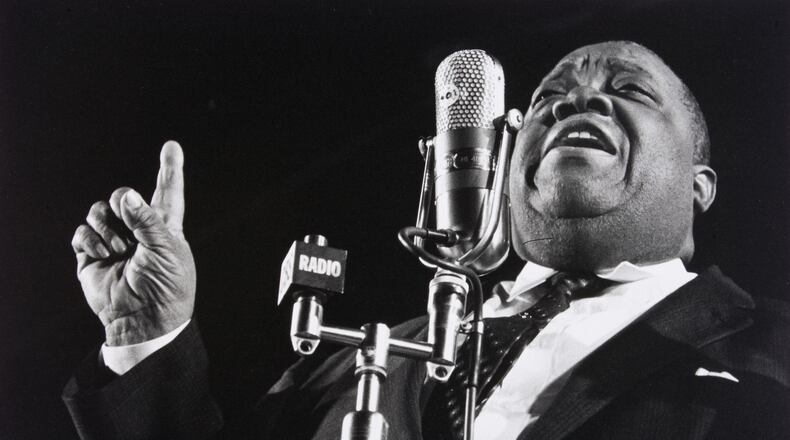In one of Herb Snitzer’s images from 1960, Louis Armstrong, the great entertainer, band-leader, composer and musician, stares thoughtfully into the lens, his shirt unbuttoned, his usual 100-watt smile relaxed into a wistful reverie, a cigarette in his right hand.
What was going on at that moment?
“He was smoking a joint,” said Snitzer with a laugh.
Well, that could explain the contemplative expression. This moment in time, snapped on a bus in the bucolic mountains of the Berkshires, is part of an exhibit of the photographer’s work, and his decades-long effort to memorialize the musicians that made jazz swing.
Eighty of those images are on display at The Breman Museum in Midtown, a show called “A Jazz Memoir,” accessible online in a virtual tour. The show is being held in conjunction with Atlanta Celebrates Photography.
What charms Snitzer about the photograph of Armstrong is the Star of David necklace visible against the musician’s bare chest.
“The Karnofsky family gave it to him for one of his early birthdays, and Louis wore it his entire life and was buried with it,” said Snitzer. The Karnofskys were a Jewish family that delivered coal and collected rags, bottles and bones around New Orleans. They lived in Armstrong’s Third Ward neighborhood, and he worked for them when he was a little boy, riding on their wagon, blowing a tin horn as they gathered refuse.
If the workday went late, he would eat at their home, and they helped him buy his first trumpet.
Armstrong’s connection to the Karnofskys is an emblem of the communion between Jews and African Americans that had a distinct influence on the growth of jazz in this country.
Credit: Herb Snitzer
Credit: Herb Snitzer
That connection is part of the rationale for this exhibit taking place at The Breman Museum, which focuses on “Jewish history, culture and arts.”
Tony Casadonte, curator at Lumière Gallery, represents Snitzer in Atlanta, and provided the prints for the show at The Breman. He said the Armstrong photo shows the relationship between the photographer and his subjects: They were at ease with each other.
“I think it shows that Herb had this trust with musicians,” said Casadonte.
Snitzer, 87, began photographing jazz musicians in 1957, as a young graduate of the Philadelphia College of Art.
In 1958, he joined the staff of the Metronome magazine, becoming a photography editor and associate editor. This put him in the middle of the action during a great flowering of jazz in Manhattan. His access is evident in the settings of many of the photographs.
After accompanying pianist and composer Thelonious Monk to a 1960 performance in Manhattan, Snitzer followed him back to Baroness Kathleen Annie Pannonica de Koenigswarter’s hotel suite. (The baroness was driving a Bentley. Snitzer was driving a Volkswagen bug.)
The baroness Pannonica, nicknamed “Nica,” was a jazz patron, and is etched into the history of the music by Monk and others, who have named songs for her, including “Pannonica,” “Nica’s Dream” and “Thelonica.”
At the hotel Monk and Snitzer played ping pong until 6 a.m. “I was a very good ping pong player if I do say so myself,” said Snitzer. “I didn’t measure up to Monk. He whipped me in three games.”
Snitzer photographed jazz musicians, street life and protests through the ’60s, then began a venture in education after a freelance assignment sent him to the Summerhill School in England.
Fascinated with the “free school” movement, he helped create the Lewis-Wadhams School in Massachusetts, and served as its headmaster for 13 years, according to Casadonte.
An encounter with Nina Simone in the 1980s brought him back to photography as a profession.
Credit: Herb Snitzer
Credit: Herb Snitzer
The deep blacks and soft grays of Herb Snitzer’s images show a talent that extends into the darkroom.
“I prided myself for being able to print well,” said Snitzer, who still shoots on film. “There is quite a difference between original prints and what comes over a computer.”
Snitzer said darkroom skills are becoming obsolete. “There are young photographers today for The New York Times, The Boston Globe, the St. Petersburg Times, that have never been in a dark, room,” he said. “They’re going to lose the ability to print.”
But Snitzer isn’t trying to turn the clock back. He has a philosophical view of the changes in photography, which has been around since the 1700s. "In terms of the history of photography, it’s a very short time. Who knows what’s going to be down the pike in 25 years?”
VIRTUAL EVENT
Herb Snitzer will give a talk on Oct. 1 at 11 a.m., in a Zoom call. Open to the public.
“A Jazz Memoir” will be displayed at The Breman Museum through Dec. 31.
1440 Spring Street, Atlanta. thebreman.org
About the Author
The Latest
Featured





